
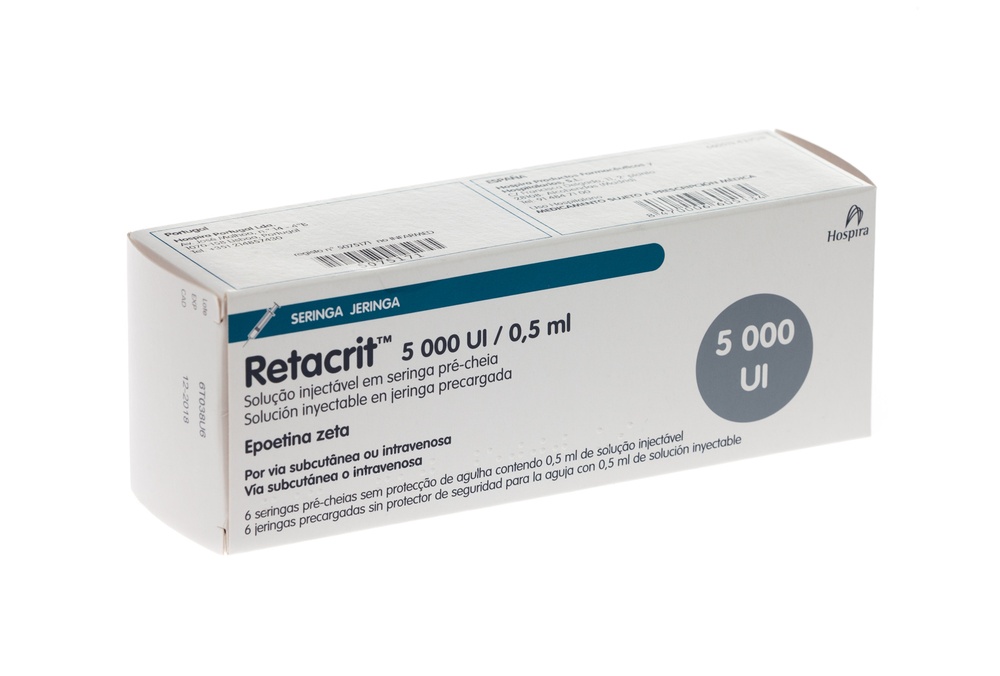
РЕТАКРИТ 5000 МЕ/0,5 мл РАСТВОР ДЛЯ ИНЪЕКЦИЙ В ПРЕДНАПОЛНЕННОМ ШПРИЦЕ

Спросите врача о рецепте на РЕТАКРИТ 5000 МЕ/0,5 мл РАСТВОР ДЛЯ ИНЪЕКЦИЙ В ПРЕДНАПОЛНЕННОМ ШПРИЦЕ

Инструкция по применению РЕТАКРИТ 5000 МЕ/0,5 мл РАСТВОР ДЛЯ ИНЪЕКЦИЙ В ПРЕДНАПОЛНЕННОМ ШПРИЦЕ
Введение
Инструкция: информация для пользователя
Ретакрит 1 000МЕ/0,3мл раствор для инъекций в предварительно заполненном шприце
Ретакрит 2 000МЕ/0,6мл раствор для инъекций в предварительно заполненном шприце
Ретакрит 3 000МЕ/0,9мл раствор для инъекций в предварительно заполненном шприце
Ретакрит 4 000МЕ/0,4мл раствор для инъекций в предварительно заполненном шприце
Ретакрит 5 000МЕ/0,5мл раствор для инъекций в предварительно заполненном шприце
Ретакрит 6 000МЕ/0,6мл раствор для инъекций в предварительно заполненном шприце
Ретакрит 8 000МЕ/0,8мл раствор для инъекций в предварительно заполненном шприце
Ретакрит 10 000МЕ/1мл раствор для инъекций в предварительно заполненном шприце
Ретакрит 20 000МЕ/0,5мл раствор для инъекций в предварительно заполненном шприце
Ретакрит 30 000МЕ/0,75мл раствор для инъекций в предварительно заполненном шприце
Ретакрит 40 000МЕ/1мл раствор для инъекций в предварительно заполненном шприце
эпоэтина зета
Прочитайте внимательно всю инструкцию перед началом использования препарата, поскольку она содержит важную информацию для вас.
- Сохраните эту инструкцию, поскольку вам может потребоваться прочитать ее снова.
- Если у вас есть какие-либо вопросы, проконсультируйтесь с вашим врачом, фармацевтом или медсестрой.
- Этот препарат был назначен только вам, и не следует передавать его другим людям, даже если у них такие же симптомы, как у вас, поскольку это может нанести им вред.
- Если вы испытываете побочные эффекты, проконсультируйтесь с вашим врачом, фармацевтом или медсестрой, даже если это побочные эффекты, которые не указаны в этой инструкции. См. раздел 4.
Содержание инструкции
- Что такое Ретакрит и для чего он используется
- Что вам нужно знать перед началом использования Ретакрита
- Как использовать Ретакрит
- Возможные побочные эффекты
- Хранение Ретакрита
- Содержание упаковки и дополнительная информация
1. Что такое Ретакрит и для чего он используется
Ретакрит содержит активное вещество эпоэтина зета, белок, который стимулирует костный мозг к производству больше красных кровяных телец, клеток, которые переносят гемоглобин (вещество, переносящее кислород). Эпоэтина зета является копией человеческого белка эритропоэтина и действует таким же образом.
- Ретакрит показан для лечения симптоматической анемии, вызванной заболеванием почек
- у детей, находящихся на гемодиализе;
- у взрослых, находящихся на гемодиализе или перитонеальном диализе;
- у взрослых с тяжелой анемией, которые еще не прошли диализ.
Если у вас есть заболевание почек, у вас может быть низкое количество красных кровяных телец, если ваши почки не производят достаточно эритропоэтина (необходимого для производства красных кровяных телец). Ретакрит назначается для стимуляции костного мозга к производству больше красных кровяных телец.
- Ретакрит показан для лечения анемии у взрослых, получающих химиотерапию для лечения солидных опухолей, злокачественных лимфом или множественной миеломы (неоплазии костного мозга), которые могут потребовать переливания крови. Ретакрит может уменьшить потребность в переливании крови у этих пациентов.
- Ретакрит показан у взрослых с умеренной анемией, которые собираются стать донорами крови передоперацией, чтобы им можно было переливать кровь во время или после операции. Поскольку Ретакрит стимулирует производство красных кровяных телец, врачи могут взять больше крови у этих людей.
- Ретакрит показан у взрослых с умеренной анемией, которые собираются пройти запланированную крупную ортопедическую операцию(например, операции по замене тазобедренного или коленного сустава)для уменьшения потенциальной потребности в переливании крови.
- Ретакрит показан у взрослых пациентов с анемией и заболеванием костного мозга, которое вызывает тяжелое нарушение производства кровяных клеток (миелодиспластические синдромы).Ретакрит может уменьшить потребность в переливании крови.
2. Что вам нужно знать перед началом использования Ретакрита
Не используйте Ретакрит
- Если вы аллергичнык эпоэтине зета или любому другому компоненту этого препарата (перечисленному в разделе 6).
- Если у вас диагностирована чистая красноклеточная аплазия(костный мозг не может производить достаточно красных кровяных телец) после предыдущего лечения любым продуктом, стимулирующим производство красных кровяных телец (включая Ретакрит). См. раздел 4.
- Если у вас есть неадекватно контролируемая артериальная гипертония.
- Для стимуляции производства красных кровяных телец (чтобы врачи могли взять больше крови у вас) если вы не можете получить переливание своей собственной кровиво время или после операции.
- Если вы собираетесь пройти запланированную крупную ортопедическую операцию (например, операцию на тазобедренном или коленном суставе) и у вас:
- тяжелое заболевание сердца;
- тяжелые нарушения вен или артерий;
- недавно перенесенный инфаркт миокарда или инсульт;
- невозможность принимать лекарства для разжижения крови.
Возможно, Ретакрит не подходит для вас. Обсудите это с вашим врачом. Некоторым людям могут потребоваться лекарства для уменьшения риска образования кровяных сгустков во время лечения Ретакритом. Если вы не можете принимать лекарства для предотвращения образования кровяных сгустков, не принимайте Ретакрит.
Предостережения и меры предосторожности
Проконсультируйтесь с вашим врачом, фармацевтом или медсестрой перед началом использования Ретакрита.
Будьте осторожны с Ретакритом
Ретакрит и другие продукты, стимулирующие производство красных кровяных телец, могут увеличить риск образования кровяных сгустков у всех пациентов.Этот риск может быть выше, если у вас есть другие факторы риска (например, если у вас был ранее кровяной сгусток или у вас есть избыточный вес, диабет, заболевание сердца или вы находитесь в постели в течение длительного времени из-за операции или болезни). Сообщите вашему врачу об этом. Ваш врач поможет вам решить, подходит ли Ретакрит для вас.
Проконсультируйтесь с вашим врачом, если вы соответствуете любой из следующих ситуаций.Возможно, вы все еще можете использовать Ретакрит, но обсудите это с вашим врачом.
- Если вы знаете, что страдаетеили страдали:
- артериальной гипертонией;
- эпилептическими приступами или судорогами;
- заболеванием печени;
- анемией по другим причинам;
- порфирией (редким заболеванием крови).
- Если вы пациент с хронической почечной недостаточностью, и особенно если вы не хорошо реагируете на Ретакрит, ваш врач проверит вашу дозу Ретакрита, поскольку повторное увеличение дозы Ретакрита, если вы не реагируете на лечение, может увеличить риск сердечно-сосудистых проблем и может увеличить риск инфаркта миокарда, инсульта и смерти.
- Если вы пациент с раком,вам следует знать, что продукты, стимулирующие производство красных кровяных телец (например, Ретакрит), могут действовать как фактор роста и, таким образом, могут повлиять на прогрессию рака. В зависимости от вашей индивидуальной ситуации, переливание крови может быть предпочтительнее. Обсудите это с вашим врачом.
- Если вы пациент с раком,вам следует знать, что использование Ретакрита может быть связано с более низкой выживаемостью и более высокой смертностью у пациентов с раком головы и шеи и метастатическим раком молочной железы, получающих химиотерапию.
- Были зарегистрированы тяжелые кожные реакции, такие как синдром Стивенса-Джонсона (ССД) и токсический эпидермальный некролиз (ТЭН) при применении эпоэтинов.
ССД/ТЭН могут начинаться как красные пятна, похожие на мишени или круглые пятна, часто с пузырьками в центре на туловище. Также могут появляться язвы во рту, горле, носу, гениталиях и глазах (раздражение и отек глаз). Эти тяжелые кожные реакции часто предшествуют лихорадке или симптомам, похожим на грипп. Эти реакции могут прогрессировать до общей отшелушивания кожи и потенциально смертельных осложнений.
Если у вас появляется тяжелая кожная реакция или любой другой из этих кожных симптомов, прекратите принимать Ретакрит и обратитесь к вашему врачу или обратитесь за медицинской помощью немедленно.
Будьте осторожны с другими продуктами, стимулирующими производство красных кровяных телец
Ретакрит относится к одной из групп продуктов, стимулирующих производство красных кровяных телец, как и человеческий белок эритропоэтин. Ваш врач должен записать точное название продукта, который вы используете.
Если во время вашего лечения вам будет введен продукт из этой группы, отличный от Ретакрита, проконсультируйтесь с вашим врачом или фармацевтом перед использованием.
Другие лекарства и Ретакрит
Сообщите вашему врачу или фармацевту, если вы используете, недавно использовали или можете использовать любое другое лекарство.
Если вы используете Ретакрит вместе с лекарством под названием циклоспорин(например, после трансплантации почки), ваш врач может запросить анализ крови для контроля уровня циклоспорина.
Добавки железа и другие стимуляторы кровимогут увеличить эффективность Ретакрита. Ваш врач решит, следует ли вам использовать их.
Если вы посещаете больницу, клинику или врача, скажите им, что вы проходите лечение Ретакритом, поскольку это может повлиять на другие лечения или результаты анализов.
Беременность, лактация и фертильность
Важно сообщить вашему врачу, если вы соответствуете любой из следующих ситуаций.Возможно, вы все еще можете использовать Ретакрит, но обсудите это с вашим врачом.
- Если вы беременны или кормите грудью, считаете, что можете быть беременной или планируете стать беременной, проконсультируйтесь с вашим врачом или фармацевтом перед использованием этого лекарства.
- Если вы кормите грудью.
Нет данных о влиянии эпоэтина зета на фертильность.
Вождение и использование машин
Влияние Ретакрита на способность управлять транспортными средствами и работать с машинами является незначительным или отсутствует.
Ретакрит содержит фенилаланин
Ретакрит содержит 0,5 мг фенилаланина на каждый мл.
Фенилаланин может быть вредным в случае фенилкетонурии (ФКН), редкого генетического заболевания, при котором фенилаланин накапливается, поскольку организм не может правильно удалить его, раздел
Ретакрит содержит натрий
Это лекарство содержит менее 1 ммоль натрия (23 мг) на дозу, что означает, что оно практически не содержит натрия.
3. Как использовать Ретакрит
Следуйте точно инструкциям по введению этого препарата, указанным вашим врачом.В случае сомнений проконсультируйтесь с вашим врачом еще раз.
Ваш врач провел анализ кровии решил, что вам нужен Ретакрит.
Ретакрит можно вводить путем инъекции:
- Илив вену или через трубку, введенную в вену (внутривенно).
- Илипод кожу (подкожно).
Ваш врач решит, каким образом будет вводиться Ретакрит. Инъекции обычно выполняются врачом, медсестрой или другим медицинским специалистом. Позже, в зависимости от причины, по которой вам нужное лечение Ретакритом, некоторые люди могут научиться самостоятельно вводить препарат под кожу: см. Инструкции по введению Ретакрита.
Ретакрит не должен использоваться:
- после даты истечения срока годности на этикетке и наружной упаковке;
- если вы знаете или предполагаете, что он мог случайно замерзнуть, или
- если произошла неисправность в холодильнике.
Доза Ретакрита, которую вы получите, основана на вашем весе тела в килограммах. Причина вашей анемии также является фактором, который ваш врач будет учитывать при определении правильной дозы.
Ваш врач будет регулярно контролировать ваше артериальное давлениево время лечения Ретакритом.
Пациенты с почечной недостаточностью
- Ваш врач будет поддерживать уровень гемоглобина между 10 и 12 г/дл, поскольку высокий уровень гемоглобина может увеличить риск тромбозов и смерти. У детей уровень гемоглобина должен поддерживаться между 9,5 и 11 г/дл.
- Обычная начальная дозаРетакрита для взрослых и детей составляет 50 МЕ/кг (международных единиц на килограмм) три раза в неделю.
- У пациентов, находящихся на перитонеальном диализе, Ретакрит можно вводить дважды в неделю.
- И у взрослых, и у детей Ретакрит вводится в виде инъекции, либо в вену (внутривенно), либо через трубку, введенную в вену. Когда доступ к вене или трубке затруднен, ваш врач может решить, что Ретакрит должен быть введен под кожу (подкожно). Это включает пациентов, находящихся на диализе, и тех, кто еще не находится на диализе.
- Ваш врач будет регулярно назначать анализы крови, чтобы увидеть, как реагирует ваша анемия, и может скорректировать дозу, обычно не чаще чем каждые четыре недели. Необходимо избегать увеличения гемоглобина более чем на 2 г/дл в течение четырех недель.
- После коррекции анемии ваш врач продолжит регулярно назначать анализы крови. Возможно, он скорректирует дозу и частоту введения Ретакрита, чтобы поддерживать вашу реакцию на лечение. Ваш врач будет использовать минимальную эффективную дозу для контроля симптомов анемии.
- Если вы не реагируете хорошо на Ретакрит, ваш врач проверит вашу дозу и сообщит вам, если необходимо изменить дозу Ретакрита.
- Если вы получаете более длительный интервал дозы (более одного раза в неделю) Ретакрита, возможно, что вы не будете поддерживать адекватные уровни гемоглобина и вам может потребоваться увеличение дозы Ретакрита или частоты его введения.
- Возможно, что вам будут назначены добавки железа до и во время лечения Ретакритом, чтобы увеличить его эффективность.
- Если на момент начала лечения Ретакритом вы находились на диализе, возможно, что вашу схему диализа необходимо скорректировать. Ваш врач решит, необходимо ли это.
Взрослые, получающие химиотерапию
- Ваш врач может начать лечение Ретакритом, если ваш уровень гемоглобина равен или ниже 10 г/дл.
- Ваш врач будет поддерживать ваш уровень гемоглобина между 10 и 12 г/дл, поскольку высокий уровень гемоглобина может увеличить риск тромбозов и смерти.
- Начальная доза составляет 150 МЕ/кг веса тела 3 раза в неделю или 450 МЕ/кг веса тела один раз в неделю.
- Ретакрит вводится путем инъекции под кожу.
- Ваш врач назначит анализы крови и может скорректировать дозу, в зависимости от того, как реагирует ваша анемия на лечение Ретакритом.
- Возможно, что вам будут назначены добавки железа до и во время лечения Ретакритом, чтобы увеличить его эффективность.
- Обычно вы будете продолжать получать лечение Ретакритом в течение месяца после окончания химиотерапии.
Взрослые доноры собственной крови
- Обычная дозасоставляет 600 МЕ/кг веса тела 2 раза в неделю.
- Ретакрит вводится путем инъекции в вену сразу после сдачи крови в течение трех недель до операции.
- Возможно, что вам будут назначены добавки железа до и во время лечения Ретакритом, чтобы увеличить его эффективность.
Взрослые, запланированные на крупную ортопедическую операцию
- Рекомендуемая дозасоставляет 600 МЕ/кг веса тела один раз в неделю.
- Ретакрит вводится путем инъекции под кожу в течение трех недель до операции и в день операции.
- В случаях, когда необходимо сократить время до операции, будет введена суточная доза 300 МЕ/кг в течение максимум 10 дней до операции, в день операции и в течение четырех дней сразу после операции.
- Если анализы крови показывают слишком высокий уровень гемоглобина до операции, лечение будет прекращено.
- Возможно, что вам будут назначены добавки железа до и во время лечения Ретакритом, чтобы увеличить его эффективность.
Взрослые с миелодиспластическим синдромом
- Ваш врач может начать лечение Ретакритом, если ваш уровень гемоглобина равен или ниже 10 г/дл. Цель лечения - поддерживать уровень гемоглобина между 10 и 12 г/дл, поскольку более высокий уровень гемоглобина может увеличить риск тромбозов и смерти.
- Ретакрит вводится путем инъекции под кожу.
- Начальная доза составляет 450 МЕ на килограмм веса тела один раз в неделю.
- Ваш врач назначит анализы крови и может скорректировать дозу, в зависимости от того, как реагирует ваша анемия на лечение Ретакритом.
Инструкции по введению Ретакрита
Когда начинается лечение, медицинский персонал обычно вводит Ретакрит. Позже ваш врач может предложить, чтобы вы или ваш опекун научились самостоятельно вводить Ретакрит под кожу (подкожно) самостоятельно.
- Не пытайтесь вводить себе Ретакрит, если ваш врач или медсестра не научили вас, как это делать.
- Следуйте точно инструкциям по введению Ретакрита, указанным вашим врачом или медсестрой.
- Используйте Ретакрит только если он был правильно хранен; см. раздел5,Хранение Ретакрита.
- Перед использованием оставьте шприц Ретакрита до тех пор, пока он не достигнет комнатной температуры. Это обычно занимает от 15 до 30 минут.
Используйте только одну дозу Ретакрита из каждого шприца.
Если Ретакрит вводится под кожу (подкожно), количество вводимого препарата обычно не превышает 1 миллилитр (1 мл) за одну инъекцию. В случае более крупных объемов необходимо выбрать несколько мест для инъекции.
Ретакрит вводится только и не смешивается с другими жидкостями для инъекции.
Не встряхивайте шприцы Ретакрита.Продолжительное интенсивное встряхивание может повредить препарат. Если препарат был сильно встряхнут, не используйте его.
Как вводить себе Ретакрит, используя предварительно заполненный шприц
- Извлеките упаковку с предварительно заполненным шприцем из холодильника.
- Извлеките блистер с предварительно заполненным шприцем из упаковки. Когда упаковка содержит несколько блистеров с предварительно заполненными шприцами, отрежьте блистер с одним предварительно заполненным шприцем по перфорации, верните остальные блистеры с предварительно заполненными шприцами в упаковку и положите упаковку обратно в холодильник.
- Откройте блистер с предварительно заполненным шприцем после извлечения из холодильника. Жидкость должна достичь комнатной температуры. Неснимайте защитный колпачок с иглы шприца, пока шприц достигает комнатной температуры.

- Проверьте шприц, чтобы убедиться, что это правильная доза, он не истек, не поврежден и жидкость прозрачна и не замерзла.
- Не используйте предварительно заполненный шприц, если:
- Упаковка открыта или повреждена.
- Препарат мутный или изменил цвет, или в жидкости есть частицы.
- Часть предварительно заполненного шприца треснула или сломана, или жидкость вытекла из шприца.
- Предварительно заполненный шприц упал. Шприц может быть сломан, даже если вы не видите трещину.
- Отсутствует защитный колпачок или он не установлен правильно.
- Истек срок годности, указанный на этикетке.
Во всех этих случаях выбросьте предварительно заполненный шприц и используйте новый.
- Выберите место для инъекции. Хорошими местами являются верхняя часть бедра и вокруг живота (абдомена), но не рядом с пупком. Меняйте место каждый день.
- Вымойте руки. Используйте антисептический тампон для дезинфекции места инъекции.
- Держите предварительно заполненный шприц за корпус, с закрытой иглой, направленной вверх.
- Недержите за головку поршня, поршень или защитный колпачок.
- Нетяните за поршень ни в коем случае.
- Неснимайте защитный колпачок с иглы шприца, пока не будете готовы ввести препарат.
- Снимите защитный колпачок с иглы шприца, держа корпус шприца и осторожно потянув за колпачок, не поворачивая его. Выбросьте защитный колпачок. Ненадевайте колпачок обратно. Ненажимайте на поршень, не трогайте иглу и не встряхивайте шприц.

- Зажмите складку кожи между большим и указательным пальцами. Несжимайте.
- Другой рукой держите предварительно заполненный шприц, как если бы он был карандашом. Используйте быстрое движение "дарта", чтобы вставить иглу под углом примерно 45 градусов в кожу.
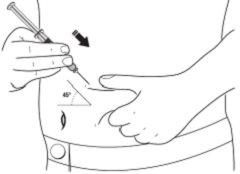
- Вставьте иглу полностью. Ваш врач или медсестра показали вам, как это сделать.
- Нажмите на поршень большим пальцем, сколько сможете, чтобы ввести всю жидкость. Нажимайте медленно и равномерно, держа кожную складку зажатой.
- Когда поршень достигнет конца, вытащите иглу и отпустите кожу.
- Когда игла будет вытащена из кожи, может быть небольшое кровотечение в месте инъекции. Это нормально. Вы можете приложить антисептический тампон к месту инъекции на несколько секунд после инъекции.
- Непытайтесь надеть защитный колпачок обратно. Утилизируйте использованный шприц в контейнере для острых предметов (защищенном от проколов).
- Никогда не кладите использованные шприцы в обычный домашний мусор.
Как вводить себе Ретакрит, используя предварительно заполненный шприц с защитным механизмом для иглы
Ваш предварительно заполненный шприц имеет защитный механизм для иглы, прикрепленный для защиты вас от случайного укола иглы.
- Извлеките упаковку с предварительно заполненным шприцем и защитным механизмом для иглы из холодильника.
- Извлеките блистер с предварительно заполненным шприцем из упаковки. Когда упаковка содержит несколько блистеров с предварительно заполненными шприцами, отрежьте блистер с одним предварительно заполненным шприцем по перфорации, верните остальные блистеры с предварительно заполненными шприцами в упаковку и положите упаковку обратно в холодильник.
- Откройте блистер с предварительно заполненным шприцем, снимая крышку блистера.
- Извлеките предварительно заполненный шприц из блистера, держа за корпус шприца.
- Нехватайте серый защитный колпачок иглы или поршень.
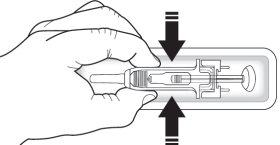
- Проверьте шприц, чтобы убедиться, что защитный механизм для иглы закрывает корпус предварительно заполненного шприца. Ненажимайте на защитный механизм для иглы на защитный колпачок до инъекции. Это может активировать или заблокировать защитный механизм для иглы. Если защитный механизм для иглы закрывает иглу, это означает, что он активирован.
- Жидкость должна достичь комнатной температуры. Неснимайте защитный колпачок с иглы шприца, пока шприц достигает комнатной температуры.
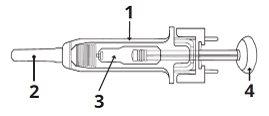
1 | Защитный механизм для иглы |
2 | Защитный колпачок иглы |
3 | Лекарство |
4 | Поршень |
- Проверьте шприц, чтобы убедиться, что это правильная доза, он не истек, не поврежден и жидкость прозрачна и не замерзла.
- Не используйте предварительно заполненный шприц, если:
- Картонная упаковка открыта или повреждена.
- Отсутствует защитный механизм для иглы, он отсоединился или активировался.
- Препарат мутный или изменил цвет, или в жидкости есть частицы. Неосматривайте продукт через пластиковую часть устройства безопасности.
- Часть предварительно заполненного шприца треснула или сломана, или жидкость вытекла из шприца.
- Предварительно заполненный шприц упал. Шприц может быть сломан, даже если вы не видите трещину.
- Отсутствует защитный колпачок или он не установлен правильно.
- Истек срок годности, указанный на этикетке.
Во всех этих случаях выбросьте предварительно заполненный шприц и используйте новый.
- Выберите место для инъекции. Хорошими местами являются верхняя часть бедра и вокруг живота (абдомена), но не рядом с пупком. Меняйте место каждый день.
- Вымойте руки. Используйте антисептический тампон для дезинфекции места инъекции.
- Держите предварительно заполненный шприц за корпус защитного механизма для иглы, с закрытой иглой, направленной вверх.
- Недержите за головку поршня, поршень или защитный колпачок.
- Нетяните за поршень ни в коем случае.
- Неснимайте защитный колпачок с иглы шприца, пока не будете готовы ввести препарат.
- Снимите защитный колпачок с иглы шприца, держа корпус шприца, и осторожно потянув за колпачок, не поворачивая его. Выбросьте защитный колпачок. Ненадевайте колпачок обратно. Ненажимайте на поршень, не трогайте иглу и не встряхивайте шприц.
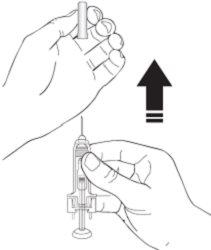
- Зажмите складку кожи между большим и указательным пальцами. Несжимайте.
- Другой рукой держите предварительно заполненный шприц, как если бы он был карандашом. Используйте быстрое движение "дарта", чтобы вставить иглу под углом примерно 45 градусов в кожу.
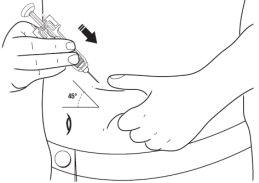
- Вставьте иглу полностью. Ваш врач или медсестра показали вам, как это сделать.
- Нажмите на поршень, держа кольцо пальцами, пока не будет введена полная доза. Защитный механизм для иглы неактивируется, пока не будет введена полная доза.
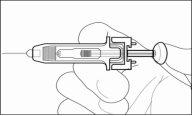
- Когда поршень достигнет конца, вытащите иглу и отпустите кожу.
- Отпустите поршень и позвольте шприцу переместиться вверх, пока вся игла не будет спрятана и заблокирована на месте.
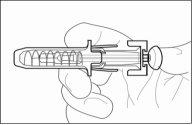
- Когда игла будет вытащена из кожи, может быть небольшое кровотечение в месте инъекции. Это нормально. Вы можете приложить антисептический тампон к месту инъекции на несколько секунд после инъекции.
- Непытайтесь надеть защитный колпачок обратно. Утилизируйте использованный шприц в контейнере для острых предметов (защищенном от проколов).
- Никогда не кладите использованные шприцы в обычный домашний мусор.
Как вводить себе Ретакрит, используя предварительно заполненный шприц с защитным устройством для иглы (ловушкой для иглы)
Ваш шприц имеет защитное устройство для иглы, которое предназначено для предотвращения случайных травм после правильного введения инъекционных препаратов. Оно состоит из пластикового устройства, которое блокирует иглу и надежно прикреплено к этикетке шприца. Вместе эти два компонента выполняют функцию ловушки для иглы (безопасности).
Пластиковое блокирующее устройство, прикрепленное к этикетке шприца, требует конкретных действий от пользователя, чтобы "активировать" его, что сделает иглу безопасной после введения инъекции:
- Извлеките упаковку с предварительно заполненным шприцем из холодильника.
- Извлеките блистер с предварительно заполненным шприцем из упаковки. Когда упаковка содержит несколько блистеров с предварительно заполненными шприцами, отрежьте блистер с одним предварительно заполненным шприцем по перфорации, верните остальные блистеры с предварительно заполненными шприцами в упаковку и положите упаковку обратно в холодильник.
- Откройте блистер с предварительно заполненным шприцем, снимая крышку блистера.
- Извлеките предварительно заполненный шприц из блистера, держа за корпус шприца.
- Нехватайте серый защитный колпачок иглы или поршень.
4. Возможные побочные эффекты
Как и все лекарства, это лекарство может вызывать побочные эффекты, хотя не все люди испытывают их.
Сообщите врачу или медсестре немедленно, если вы испытываете любой из эффектов, перечисленных в следующем списке.
Были зарегистрированы тяжелые кожные высыпания, такие как синдром Стивенса-Джонсона и токсический эпидермальный некролиз, при приеме эпоэтина. Эти реакции могут появиться как красные пятна или пятна, часто с пузырьками в центре на туловище, отслоение кожи и язвы во рту, горле, носу, гениталиях и глазах, и могут предшествовать лихорадке и симптомам, подобным гриппу. Прекратите использовать Ретакрит, если у вас出现ят эти симптомы, и свяжитесь с врачом или медсестрой немедленно. См. также раздел 2.
Очень часто: могут поражать более 1 из 10 человек.
- Диарея
- Расстройство желудка
- Рвота
- Лихорадка
- У пациентов с почечной недостаточностью, которые еще не проходили диализ, сообщалось о закупорке дыхательных путей, таких как насморк и боль в горле.
Часто: могут поражать до 1 из 10 человек.
- Увеличение артериального давления.Головные боли, особенно внезапные, острые и мигренозные, чувство замешательства или судорогимогут быть признаками внезапного увеличения артериального давления. Это требует срочного лечения. Это увеличение может потребовать лечения лекарствами (или коррекции дозировки лекарств, которые вы уже принимаете для артериальной гипертонии).
- Тромбы(включая глубокую вену и эмболию), которые могут потребовать срочного лечения. Вы можете испытывать боль в груди, трудности с дыханием и болезненное опухание и покраснение, обычно в одной ноге.
- Кашель.
- Зуд кожи, который может быть результатом аллергической реакции.
- Боль в костях или мышцах
- Симптомы, подобные гриппу, такие как головная боль, онемение и боль в суставах, чувство слабости, озноб, усталость и головокружение. Они могут быть более частыми в начале лечения. Если вы испытываете эти симптомы во время внутривенной инъекции, более медленная инъекция может помочь предотвратить их повторение.
- Покраснение, жжение и боль в месте инъекции
- Отек лодыжек, ног или пальцев
- Боль в руке или ноге
Редко: могут поражать до 1 из 100 человек.
- Высокие уровни калия в крови, которые могут вызвать аномальный сердечный ритм (это очень распространенный побочный эффект у пациентов, проходящих диализ).
- Тремор
- Закупорка носа или дыхательных путей
- Аллергическая реакция
- Кожные высыпания (уртикария)
Редко: могут поражать до 1 из 1000 человек.
- Симптомы чистой апластической анемии (АПР).
АПР - это неспособность производить достаточно красных кровяных телец в костном мозге. АПР может вызвать внезапную и тяжелую анемию. Симптомы:
- Необычная усталость,
- Чувство головокружения,
- Трудности с дыханием.
Были зарегистрированы очень редкие случаи АПР в основном у пациентов с почечной недостаточностью после месяцев или лет лечения Ретакритом и другими продуктами, стимулирующими производство красных кровяных телец.
- Может произойти увеличение количества небольших кровяных телец (так называемых тромбоцитов), которые обычно участвуют в образовании тромбов. Ваш врач проверит это.
- Тяжелые аллергические реакции, которые могут включать:
- отек лица, губ, рта, языка или горла;
- трудности с глотанием или дыханием;
- зудящая сыпь (уртикария).
- Расстройство, поражающее кровь, которое может вызвать боль, темную мочу или повышенную чувствительность кожи к солнечному свету (порфирия).
Если вы проходите гемодиализ:
- Могут образовываться тромбы(тромбоз) в фистуле диализа. Это более часто встречается, если у вас низкое артериальное давление или если ваша фистула имеет осложнения.
- Также могут образовываться тромбыв вашей системе гемодиализа. Ваш врач может решить увеличить дозу гепарина во время диализа.
Если вы испытываете любой из этих эффектов или если вы заметите любой другой эффект во время лечения Ретакритом, сообщите об этом врачу или медсестре немедленно.
Сообщение о побочных эффектах
Если вы испытываете любой побочный эффект, обратитесь к врачу, фармацевту или медсестре, даже если это возможный побочный эффект, который не указан в этом листке-вкладыше. Вы также можете сообщить об этом напрямую через Испанскую систему фармаковигиланса для лекарств для человека: www.notificaRAM.es. Сообщая о побочных эффектах, вы можете внести свой вклад в предоставление более подробной информации о безопасности этого лекарства.
5. Хранение Ретакрита
Храните это лекарство в недоступном для детей месте.
Не используйте это лекарство после срока годности, указанного на коробке и этикетке после "EXP". Срок годности - последний день месяца, указанного.
Храните в холодильнике (2°C - 8°C). Вы можете извлечь Ретакрит из холодильника и хранить его при комнатной температуре (до 25°C) в течение максимум 3 дней. Как только шприц извлечен из холодильника и достигает комнатной температуры (до 25°C), его необходимо использовать в течение трех дней или выбросить.
Не замораживайте и не встряхивайте.
Храните в наружной упаковке, чтобы защитить от света.
Не используйте это лекарство, если вы заметите, что упаковка повреждена или если жидкость имеет цвет или вы можете увидеть частицы, плавающие в ней. Если вы заметите любую из этих ситуаций, выбросьте лекарство.
Лекарства не должны выбрасываться в канализацию или мусор. Спросите у фармацевта, как утилизировать упаковку и лекарства, которые вам больше не нужны. Таким образом, вы поможете защитить окружающую среду.
6. Содержимое упаковки и дополнительная информация
Состав Ретакрита
Активное вещество - эпоэтин зета (полученный с помощью технологии рекомбинантной ДНК в клетках яичников китайского хомяка).
Ретакрит 1000 UI/0,3 мл раствор для инъекции в предварительно заполненном шприце
1 предварительно заполненный шприц с 0,3 мл раствора для инъекции содержит 1000 международных единиц (МЕ) эпоэтина зета (рекомбинантного человеческого эритропоэтина). Раствор содержит 3333 МЕ эпоэтина зета на мл.
Ретакрит 2000 UI/0,6 мл раствор для инъекции в предварительно заполненном шприце
1 предварительно заполненный шприц с 0,6 мл раствора для инъекции содержит 2000 международных единиц (МЕ) эпоэтина зета (рекомбинантного человеческого эритропоэтина). Раствор содержит 3333 МЕ эпоэтина зета на мл.
Ретакрит 3000 UI/0,9 мл раствор для инъекции в предварительно заполненном шприце
1 предварительно заполненный шприц с 0,9 мл раствора для инъекции содержит 3000 международных единиц (МЕ) эпоэтина зета (рекомбинантного человеческого эритропоэтина). Раствор содержит 3333 МЕ эпоэтина зета на мл.
Ретакрит 4000 UI/0,4 мл раствор для инъекции в предварительно заполненном шприце
1 предварительно заполненный шприц с 0,4 мл раствора для инъекции содержит 4000 международных единиц (МЕ) эпоэтина зета (рекомбинантного человеческого эритропоэтина). Раствор содержит 10 000 МЕ эпоэтина зета на мл.
Ретакрит 5000 UI/0,5 мл раствор для инъекции в предварительно заполненном шприце
1 предварительно заполненный шприц с 0,5 мл раствора для инъекции содержит 5000 международных единиц (МЕ) эпоэтина зета (рекомбинантного человеческого эритропоэтина). Раствор содержит 10 000 МЕ эпоэтина зета на мл.
Ретакрит 6000 UI/0,6 мл раствор для инъекции в предварительно заполненном шприце
1 предварительно заполненный шприц с 0,6 мл раствора для инъекции содержит 6000 международных единиц (МЕ) эпоэтина зета (рекомбинантного человеческого эритропоэтина). Раствор содержит 10 000 МЕ эпоэтина зета на мл.
Ретакрит 8000 UI/0,8 мл раствор для инъекции в предварительно заполненном шприце
1 предварительно заполненный шприц с 0,8 мл раствора для инъекции содержит 8000 международных единиц (МЕ) эпоэтина зета (рекомбинантного человеческого эритропоэтина). Раствор содержит 10 000 МЕ эпоэтина зета на мл.
Ретакрит 10 000 UI/1 мл раствор для инъекции в предварительно заполненном шприце
1 предварительно заполненный шприц с 1 мл раствора для инъекции содержит 10 000 международных единиц (МЕ) эпоэтина зета (рекомбинантного человеческого эритропоэтина). Раствор содержит 10 000 МЕ эпоэтина зета на мл.
Ретакрит 20 000 UI/0,5 мл раствор для инъекции в предварительно заполненном шприце
1 предварительно заполненный шприц с 0,5 мл раствора для инъекции содержит 20 000 международных единиц (МЕ) эпоэтина зета (рекомбинантного человеческого эритропоэтина). Раствор содержит 40 000 МЕ эпоэтина зета на мл.
Ретакрит 30 000 UI/0,75 мл раствор для инъекции в предварительно заполненном шприце
1 предварительно заполненный шприц с 0,75 мл раствора для инъекции содержит 30 000 международных единиц (МЕ) эпоэтина зета (рекомбинантного человеческого эритропоэтина). Раствор содержит 40 000 МЕ эпоэтина зета на мл.
Ретакрит 40 000 UI/1 мл раствор для инъекции в предварительно заполненном шприце
1 предварительно заполненный шприц с 1 мл раствора для инъекции содержит 40 000 международных единиц (МЕ) эпоэтина зета (рекомбинантного человеческого эритропоэтина). Раствор содержит 40 000 МЕ эпоэтина зета на мл.
Другие компоненты - дигидрат дигидрофосфата натрия, дигидрат фосфата натрия, хлорид натрия (см. раздел 2 "Ретакрит содержит натрий"), дигидрат хлорида кальция, полисорбат 20, глицин, лейцин, изолейцин, треонин, глутаминовая кислота, фенилаланин (см. раздел 2 "Ретакрит содержит фенилаланин"), вода для инъекций, гидроксид натрия (для коррекции pH), соляная кислота (для коррекции pH).
Внешний вид продукта и содержимое упаковки
Ретакрит - прозрачный и бесцветный раствор для инъекции, представленный в шприцах из прозрачного стекла с фиксированной иглой для инъекции.
Предварительно заполненные шприцы содержат от 0,3 до 1 мл раствора, в зависимости от содержания эпоэтина зета (см. "Состав Ретакрита").
Каждая упаковка включает 1, 4 или 6 предварительно заполненных шприцев с или без защитного чехла для иглы или с блокирующим пластиковым чехлом, прикрепленным к этикетке шприца.
Многоупаковочные наборы содержат 4 (4 упаковки по 1) или 6 (6 упаковок по 1) предварительно заполненных шприцев.
Владелец разрешения на маркетинг
Pfizer Europe MA EEIG
Бульвар де ла Плен 17
1050 Брюссель
Бельгия
Производители
Hospira Zagreb d.o.o.
Прудницка цеста 60
10291 Пригорье Брдовечко
Хорватия
Вы можете получить больше информации о этом лекарстве, обратившись к местному представителю владельца разрешения на маркетинг:
Испания
Pfizer, S.L.
Телефон: +34 91 490 99 00
Дата последнего пересмотра этого листка-вкладыша: 07/2023.
Подробная информация о этом лекарстве доступна на сайте Европейского агентства по лекарствам: http://www.ema.europa.eu.
- Страна регистрации
- Активное вещество
- Требуется рецептДа
- Производитель
- Информация носит справочный характер и не является медицинской рекомендацией. Перед приемом любых препаратов проконсультируйтесь с врачом. Oladoctor не несет ответственности за медицинские решения, принятые на основе этого контента.
- Аналоги РЕТАКРИТ 5000 МЕ/0,5 мл РАСТВОР ДЛЯ ИНЪЕКЦИЙ В ПРЕДНАПОЛНЕННОМ ШПРИЦЕФорма выпуска: ИНЪЕКЦИОННЫЙ РАСТВОР, 20000 МЕАктивное вещество: erythropoietinПроизводитель: Sandoz GmbhТребуется рецептФорма выпуска: ИНЪЕКЦИОННЫЙ РАСТВОР, 20 000 МЕАктивное вещество: erythropoietinПроизводитель: Sandoz GmbhТребуется рецептФорма выпуска: ИНЪЕКЦИОННЫЙ РАСТВОР, 40 000 МЕ/мл эритропоэтина альфаАктивное вещество: erythropoietinПроизводитель: Sandoz GmbhТребуется рецепт
Аналоги РЕТАКРИТ 5000 МЕ/0,5 мл РАСТВОР ДЛЯ ИНЪЕКЦИЙ В ПРЕДНАПОЛНЕННОМ ШПРИЦЕ в других странах
Лучшие аналоги с тем же действующим веществом и терапевтическим эффектом.
Аналог РЕТАКРИТ 5000 МЕ/0,5 мл РАСТВОР ДЛЯ ИНЪЕКЦИЙ В ПРЕДНАПОЛНЕННОМ ШПРИЦЕ в Украина
Врачи онлайн по РЕТАКРИТ 5000 МЕ/0,5 мл РАСТВОР ДЛЯ ИНЪЕКЦИЙ В ПРЕДНАПОЛНЕННОМ ШПРИЦЕ
Консультация по дозировке, побочным эффектам, взаимодействиям, противопоказаниям и продлению рецепта на РЕТАКРИТ 5000 МЕ/0,5 мл РАСТВОР ДЛЯ ИНЪЕКЦИЙ В ПРЕДНАПОЛНЕННОМ ШПРИЦЕ – по решению врача и с учетом местных правил.














